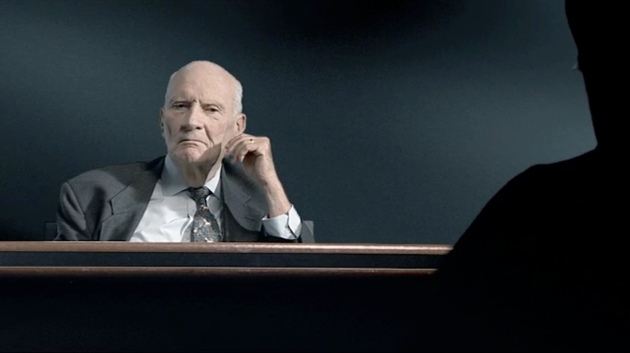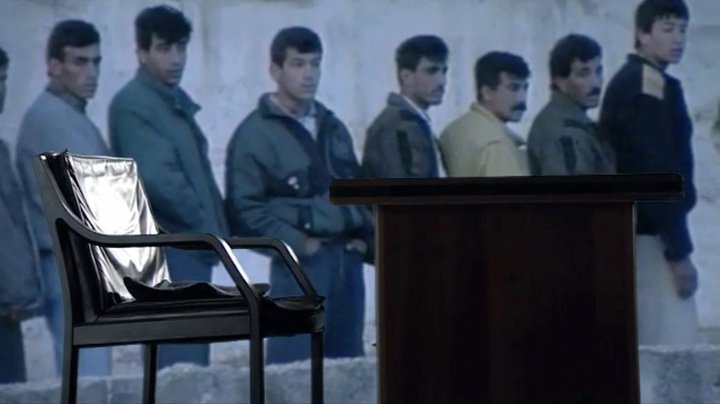This is the second in an NYRblog series about the fate of democracy in different parts of the world.
In 1979, a group of Palestinian farmers filed a petition with Israel’s High Court of Justice, claiming their land was being illegally expropriated by Jewish settlers. The farmers were not Israeli citizens, and the settlers appeared to have acted with the state’s support; indeed, army helicopters had escorted them to the land—a hilltop near Nablus—bringing along generators and water tanks. The High Court of Justice nevertheless ordered the outpost dismantled. “The decision of the court… proved that ‘there was justice’ in Jerusalem and that Israel was indeed ruled by Law,” exulted one Israeli columnist.
But the frustration of the settlers did not last very long. As revealed in The Law in These Parts, an engrossing new Israeli documentary making its American debut at the Sundance Film Festival, just hours after the ruling was handed down, Ariel Sharon, a keen supporter of the settlement project who was then Israel’s Minister of Agriculture, organized a meeting to discuss how to circumvent it. Alexander Ramati, then a legal advisor to the West Bank military command, raised his hand to tell Sharon about an Ottoman concept known as “Mawat land.” The Ottomans, who had controlled Palestine until World War I, had used the term to designate land far enough from any neighboring village that a crowing rooster perched on its edge could not be heard. Under Ottoman law, if such land was not cultivated for three years it was “mawat”—dead —and reverted to the empire. “With or without your rooster, be at my office at 8:00 in the morning,” Sharon told Ramati, who was soon crisscrossing the West Bank in the cockpit of a helicopter, identifying tens of thousands of uninhabited acres that could be labeled “state land” and made available to settlers, notwithstanding the Geneva Convention’s prohibition on moving civilians into occupied territory. In the years that followed, a string of new settlements was built on this territory, eventually prompting another challenge before the Israeli High Court. This time, the Court denied the challenge, ruling that settlement construction was permissible while Israel served as the temporary custodian of the territory. This provided a legal basis for land expropriation that has since enabled hundreds of thousands of Israelis to relocate to the West Bank.
Surprisingly little is known about the legal apparatus that has enabled and structured the occupation. Filmed in nine days but based on years of archival research, The Law in These Parts aims to expose it. Even before the 1967 Six-Day War, the film reveals, officers in the army’s legal corps drew up guidelines for a separate system of laws that could be applied to territory under IDF control, rules they were convinced could strike a balance between order and justice. But by the time the first Palestinian Intifada erupted in 1987, detention without trial and convictions based on secret evidence had become standard operating procedure in the military courts entrusted with this task. One reason Israel did not simply extend its own laws to the West Bank and Gaza Strip was that doing so would “imply certain things you may not want,” an official in the film explains – in particular, that Palestinians living in the occupied territories were citizens with the same rights as Israelis. (In contrast, Jewish settlers in places like Hebron were spared the military justice system and granted access to civilian courts in Israel.) Director Ra’anan Alexandrowicz, an Israeli known for his meticulously researched documentaries, initially planned to make these Palestinians the film’s protagonists. Instead, the documentary focuses on the handful of Israeli legal officials who, working largely in the shadows, set the ground rules for an occupation now in its forty-fifth year.
The architects of this parallel justice system believed that what they were designing was enlightened and progressive, a sentiment some viewers of the film may initially be inclined to share. At the insistence of Meir Shamgar, an elderly man with an august bearing who served as Israel’s Military Advocate General from 1963 to 1968, it was agreed soon after the Six-Day War that Palestinians could appeal cases to Israel’s High Court of Justice. Shamgar, who later served as the High Court’s president, notes that international law did not require Israel to grant Palestinians such access and expresses considerable pride in this. “I hope other countries will emulate the practice,” he says.
Like all the people interviewed in the film, Shamgar is seated in a black leather chair set behind a desk that is mounted on a stage, an arrangement that makes it easy to imagine him in court, with the gavel – and the power to mete out judgment – in his hands. In the film, of course, this power actually rests with Alexandrowicz, a deft interviewer who patiently draws out his subjects but is not shy about airing his opinions – as, for example, after an exchange with Shamgar about a High Court case in which a Palestinian living near Hebron challenged the expropriation of so-called “state land.” It was Shamgar who presided over the case and who ruled that while international law barred Israel from assuming ownership of the territory, building temporary outposts was permissible. Half-a-million Israelis now live in these “temporary” settlements, notes Alexandrowicz. “Look, I don’t think this is connected to Supreme Court rulings,” says Shamgar, attributing what happened to politics. But Alexandrowicz points out that international law “clearly forbids transferring population from the occupying state to the occupied area.” He asks Shamgar, “Why didn’t the court see this as something it needed to stand up against?” Shamgar glances to the side, a trace of exasperation ruffling his face. “That is a question after the fact,” he says.
Advertisement
“Justice Shamgar doesn’t see the connection between Supreme Court rulings and our settlements in the occupied territories,” Alexandrowicz then says in a voiceover. “But I, the person documenting, see a connection, and I present the rulings and events as I understand them. Because in the world of the film, I rule on what reality is.” As the statement suggests, The Law in These Parts makes no claim to being objective: as the narrative unfolds, it becomes increasingly apparent that the film is putting its subjects on trial before the audience. In another scene, Alexandrowicz interviews a former military judge about a case involving a Palestinian arrested without being told what he’d done wrong. To protect Israel’s sources in the territories, Palestinians often could be shown only a “paraphrase” of the charges against them, the judge explains. And what if the security forces made unreliable accusations? “As a rule, I didn’t doubt what they said,” says the judge. This revealing admission was extracted from an interview that lasted more than three hours. “The viewer is only hearing a ‘paraphrase’ of my interview,” says Alexandrowicz. Here as elsewhere, he slyly anticipates (and thus potentially defuses) the charge that his view is biased, while implicitly raising the same question about the supposedly neutral officials who held sway in courtrooms where the disparity in power, and the absence of objectivity, was far more glaring.
Alexandrowicz’s unsparing inquiry is targeted at Israelis and foreign observers, who trumpet the achievements of Israel’s democracy and the High Court’s willingness to restrain abuses even at the occasional expense of security. The Law in These Parts does not deny that the High Court has successfully put a stop to some abuses in the territories—most notably in a 1999 ruling that barred various methods of physical interrogation (shaking, hooding, and shackling detainees) practiced for years with impunity. Like the 1979 decision on settlements, it infuriated some Israelis on the right, particularly since it came a few years after a wave of suicide bombings. On other occasions, the High Court has issued rulings—requiring, for example, that Israel re-route its security barrier to expropriate less Palestinian land—that the army has refused to enforce. But the film disquietingly suggests that these occasional displays of independence may only serve to foster the illusion of justice even as separate laws for settlers, house demolitions, restrictions on free movement and a host of other unjust policies obtained “a legal seal of approval,” as Ilan Katz, who served as Deputy Military Advocate General from 2000 to 2003, puts it in the film. The Knesset could easily have passed a law barring Palestinians from petitioning the High Court, notes Katz. Why didn’t it? “Because many times the Supreme Court is convenient for the security forces,” he says.
The Law in These Parts appeared in Israel during a period in which many of the organs of an independent civil society – including the civil court system – have been under attack. The repressive climate may explain why the film has generated enormous interest in Israel, screening in more than 100 locations and receiving the prize for best documentary at the 2011 Jerusalem Film Festival. Of course, the warm reception also underscores a paradox: while many Israelis seem open and even sympathetic to critical examinations of the occupation, no political constituency has emerged to challenge the creeping colonization of East Jerusalem and the West Bank, which has continued to advance under the Netanyahu government. The film’s subjects have been more sparing with their praise – with one notable exception, a former military judge named Jonathan Livny who has attended some screenings and spoken admiringly about it. At one point in the film, Livny is openly critical of the military courts: “As a military judge, you don’t just represent justice,” he says. “You represent the authorities of the occupation, vis-à-vis a population that sees you as the enemy… It’s an unnatural situation. As long as it’s only temporary, fine. But when it goes on for 40 years? How can the system function? How can it be just?”
Advertisement
It is the closest any of the film’s subjects come to admitting to a troubled conscience, and it made me wonder whether the experience of being cross-examined in the studio had forced Livny to grapple with the compromises he’d made. “Yes,” he told me when I reached him recently by phone, “it’s become an educational moment in my life. It enabled me to sit for three hours and really look inwardly and go through a process of understanding and come to grips, through the questioning, with my emotions, my feelings, with trying to understand the role I played.” I asked him if he ever looked back and thought he should have followed the lead of the hundreds of Israeli soldiers who refused to serve in the occupied territories. “Never,” he said. “Because I realized that if I wouldn’t do it and somebody else would be in my place, that person would not even have the qualms that I showed.” Many of his colleagues viewed the settlements favorably, he told me. Some even lived in them. Few understood Arabic, which he spoke fluently. Still, he said, he regarded the system in which he’d served as a place where cultivating respect for the rule of law was impossible. “It is a kangaroo court.”
We spoke in early January, a week after Israel’s High Court ruled on a petition challenging the right of Israeli companies to mine in eight quarries situated across the Green Line. The materials are sold overwhelmingly to Israelis —“looting the West Bank,” in the words of Dror Etkes, a researcher formerly with the organization Yesh Din, which submitted the complaint—in seemingly clear violation of a provision of the Hague Convention requiring an occupying power to serve only as the “administrator” of such resources. The High Court rejected the challenge, ruling that the occupation has gone on for so long that the situation has acquired certain “unique characteristics.” About this, at least, Ra’anan Alexandrowicz might agree.
The Law in These Parts will be shown at the Sundance Film Festival on January 26 and 27.




